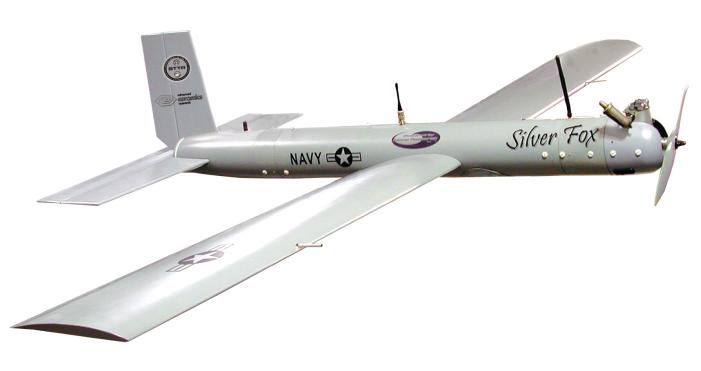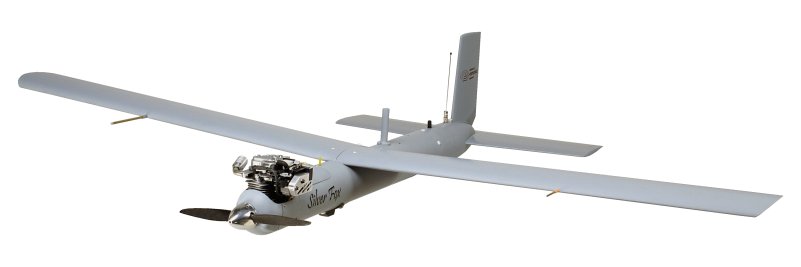Advanced Ceramics Research / ONR Silver Fox
The Office of Naval Research originally developed the Silver Fox reconnaissance UAV in 2002 to spot whales in naval operating areas to keep them out of harm's way before beginning a naval exercise. However, in January 2003, the ONR was asked by the Marine Corps to rapidly build Silver Fox systems for use as tactical RISTA (Reconnaissance, Intelligence, Surveillance and Target Acquisition) UAVs for small units. ONR teamed with Advanced Ceramics Research Inc., and within two months the first six Silver Fox UAVs were delivered.
 |
| Photo: Advanced Ceramics Research |
| Silver Fox (early configuration) |
The Silver Fox is of modular construction, and is powered by a small model airplane piston engine. It can be equipped with straight wings of various sizes, allowing to trade duration and payload weight for speed or vice versa. The 12 kg (26 lb) UAV can be launched by hand, but normally a compressed-air driven launcher is used. It is equipped with a GPS navigation system to fly fully autonomous missions of up to ten hours duration. The mission is pre-planned using the laptop computer of the ground control station. Operational radius of the baseline UAV is determined by the 37 km (20 nm) range of the system's line-of-sight datalink. Typical mission altitude is 150-365 m (500-1200 ft) above ground. The current Silver Fox vehicles are equipped with infrared and high-resolution color zoom video cameras, which send their imagery in real-time to the operator's display screen. However, the vehicle could also employ other sensors with a weight of up to 1.8 kg (4 lb) in its payload section.
 |
| Photo: Advanced Ceramics Research |
| Silver Fox (current "Block B-3" configuration) |
Development of the Silver Fox is currently continuing, primarily in the area of new sensors. These can include biological and chemical agent detectors, and improved camera systems with automatic recording capabilities, gimballing and/or improved zoom capabilities. Using data recording, the Silver Fox is expected to fly automatic missions at a range of up to 290 km (180 miles). The latest flight control system supports a fully autonomous "convoy reconnaissance" mode, where the UAV flies automatically ahead of a control vehicle in the convoy. Finally, by using a modified engine burning diesel fuel instead of gasoline, the flight duration might be improved to 20 hours.
Specifications
Note: Data given by several sources show slight variations. Figures given below may therefore be inaccurate!
Data for Silver Fox Block B-3:
| Length | 1.47 m (4 ft 10 in) |
| Wingspan | variable; max: 2.39 m (7 ft 10 in) |
| Weight | 12 kg (26 lb) |
| Speed | max: 102 km/h (63 mph); cruise: 80 km/h (50 mph) |
| Ceiling | 3650 m (12000 ft) |
| Range | 37 km (20 nm) |
| Endurance | 10 h |
| Propulsion | 1-cyl 4-stroke piston engine |
Main Sources
[1] Office of Naval Research Website
[2] Advanced Ceramics Research Website
[3] "Unmanned Aircraft Systems Roadmap, 2005-2030", Office of the Secretary of Defense, August 2005
Back to Directory of U.S. Military Rockets and Missiles, Appendix 4
Last Updated: 19 January 2006